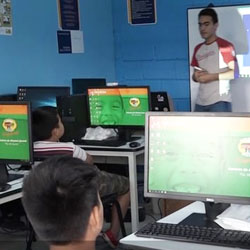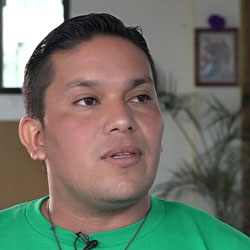Tela, HondurasIn a crowded classroom in the 15th of September neighborhood Outreach Center, a group of young men and women gather for an unlikely discussion. The topic is masculinity and connections between “machismo”— a strong and aggressive expression of one’s manliness—and violence.
“Machismo poses that men are the strong sex and that men don’t express their emotions,” explains Carlos Guzman, a Master Trainer for the course and Sub-Coordinator of the Northern Region with the Alianza Joven Honduras project, which runs the course. “When I see [as a child] that expressing violence is a way of demonstrating my manhood, then I express my manhood through violence.”
While Honduras experiences one of the highest homicide rates in the world, levels of violence against women and girls are also alarming.
Four in 10 Honduran women surveyed reported having suffered from some form of violence against women and girls, according to a 2015 U.S. Agency for International Development survey. Commonly cited contributors included patriarchal culture, machismo, drug and alcohol abuse, and a lack of family role models, among others.
For many young women growing up here, the effects of machismo are profound.
“I believe that machismo affects people as to the definition of what women do and men do not. I think it makes us feel inferior as women. The men, because they are men, have more force than we women,” says Elizabeth Guity, a 20-year-old participant in the Outreach Center discussion.
As part of the broader youth-focused crime and violence prevention program, the Alianza Joven Honduras (Youth Alliance Honduras) project is prompting young men and women to think about stereotypes and how certain societal pressures on young men can lead to risky and sometimes violent behaviors. The project is funded by USAID and implemented by Creative Associates International.
To date, the program has carried out such masculinity workshops in 58 neighborhood Outreach Centers across the country, reaching more than 2,300 male and female youth ages 12 to 30. Youth take the course with peers around the same age.
Building a new “positive masculinity”
Guided by a trained instructor, the three-part masculinity workshops lead youth through three workbooks on violence prevention, how machismo affects men and women and how to build a positive masculinity that promotes healthy behaviors and relationships. It was originally developed by the Center for Violence Prevention in Nicaragua.
For young men raised in a society that emphasizes being “tough” and imparts this machismo through social norms, behaviors and attitudes, these workshops can be the first time they encounter a new prism through which to view masculinity.
Master Trainer Guzman says years of repressing emotions and experiences and acting “tough” is damaging to young men and can lead to violence.
“There comes a point where they have to explode and when that moment of explosion arrives, that catharsis, is when violence can occur,” he says.
Through frank discussions and guided exercises, instructors support young men in developing a “positive masculinity” through effective communication and conflict resolution, and expressing rather than repressing emotions.
Women and girls also play a critical role in this transformation, explains Guzman.
The goal is “building a society with a positive masculinity, in which young people understand where the problem of machismo is, how we can solve it and how we can build a positive masculinity together,” he says.
Before taking the masculinity course, 18-year-old Romel Alexander hadn’t thought much about the ways in which machismo affected his life. He now sees it—bravado over being bigger or stronger than someone else and pressure to conceal any weakness or emotion.
“You should also treat people well,” he says now, after taking the course. “It was also good that we should see, as men, that we could express” emotions.
Young women in the course are also internalizing these messages and carrying them forward.
“I know how I can be treated by a man, what treatment I should receive and how I should behave in society,” says Guity. “I know how to talk to children too, not to continue carrying this machismo generation after generation, but to stop it with my example, with what I learned in that workshop.”
Sharing the message to stop violence
To reach as many people as possible with this message, masculinity workshop instructors prepare mentors and other trainers in the communities who then replicate the workshops in schools, churches and community meetings.
“This machismo not only affects young people, but affects the whole family; youth, adults, children, adolescents, parents, mothers,” says Guzman. “The more access people have to the methodology the easier it is to address the problem.”
Students of the course believe it can be a tool to prevent violence. Many say that they plan to play a role in advancing the message themselves to peers and to the next generation.
“I can affect communication,” says Alexander. “Tomorrow, when I am grown up, I’ll take what I’ve learned [in the course] to set an example for my children.”
With reporting by Emanuel Rodriguez


